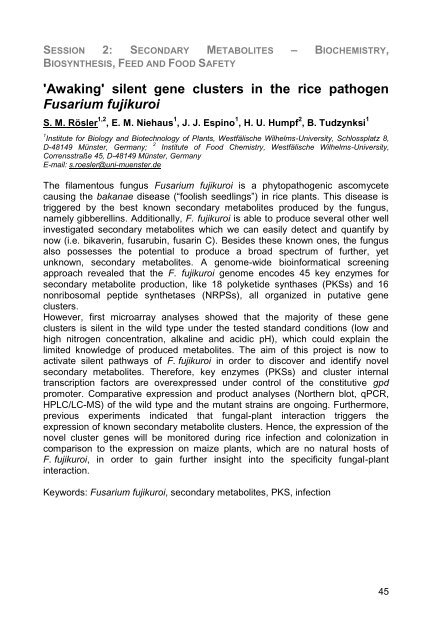EFS12- Book of abstracts - Contact
EFS12- Book of abstracts - Contact
EFS12- Book of abstracts - Contact
You also want an ePaper? Increase the reach of your titles
YUMPU automatically turns print PDFs into web optimized ePapers that Google loves.
SESSION 2: SECONDARY METABOLITES – BIOCHEMISTRY,<br />
BIOSYNTHESIS, FEED AND FOOD SAFETY<br />
'Awaking' silent gene clusters in the rice pathogen<br />
Fusarium fujikuroi<br />
S. M. Rösler 1,2 , E. M. Niehaus 1 , J. J. Espino 1 , H. U. Humpf 2 , B. Tudzynksi 1<br />
1 Institute for Biology and Biotechnology <strong>of</strong> Plants, Westfälische Wilhelms-University, Schlossplatz 8,<br />
D-48149 Münster, Germany; 2 Institute <strong>of</strong> Food Chemistry, Westfälische Wilhelms-University,<br />
Corrensstraße 45, D-48149 Münster, Germany<br />
E-mail: s.roesler@uni-muenster.de<br />
The filamentous fungus Fusarium fujikuroi is a phytopathogenic ascomycete<br />
causing the bakanae disease (“foolish seedlings”) in rice plants. This disease is<br />
triggered by the best known secondary metabolites produced by the fungus,<br />
namely gibberellins. Additionally, F. fujikuroi is able to produce several other well<br />
investigated secondary metabolites which we can easily detect and quantify by<br />
now (i.e. bikaverin, fusarubin, fusarin C). Besides these known ones, the fungus<br />
also possesses the potential to produce a broad spectrum <strong>of</strong> further, yet<br />
unknown, secondary metabolites. A genome-wide bioinformatical screening<br />
approach revealed that the F. fujikuroi genome encodes 45 key enzymes for<br />
secondary metabolite production, like 18 polyketide synthases (PKSs) and 16<br />
nonribosomal peptide synthetases (NRPSs), all organized in putative gene<br />
clusters.<br />
However, first microarray analyses showed that the majority <strong>of</strong> these gene<br />
clusters is silent in the wild type under the tested standard conditions (low and<br />
high nitrogen concentration, alkaline and acidic pH), which could explain the<br />
limited knowledge <strong>of</strong> produced metabolites. The aim <strong>of</strong> this project is now to<br />
activate silent pathways <strong>of</strong> F. fujikuroi in order to discover and identify novel<br />
secondary metabolites. Therefore, key enzymes (PKSs) and cluster internal<br />
transcription factors are overexpressed under control <strong>of</strong> the constitutive gpd<br />
promoter. Comparative expression and product analyses (Northern blot, qPCR,<br />
HPLC/LC-MS) <strong>of</strong> the wild type and the mutant strains are ongoing. Furthermore,<br />
previous experiments indicated that fungal-plant interaction triggers the<br />
expression <strong>of</strong> known secondary metabolite clusters. Hence, the expression <strong>of</strong> the<br />
novel cluster genes will be monitored during rice infection and colonization in<br />
comparison to the expression on maize plants, which are no natural hosts <strong>of</strong><br />
F. fujikuroi, in order to gain further insight into the specificity fungal-plant<br />
interaction.<br />
Keywords: Fusarium fujikuroi, secondary metabolites, PKS, infection<br />
45
















![Présentation CRB-anim [Mode de compatibilité] - Inra](https://img.yumpu.com/17418636/1/190x135/presentation-crb-anim-mode-de-compatibilite-inra.jpg?quality=85)